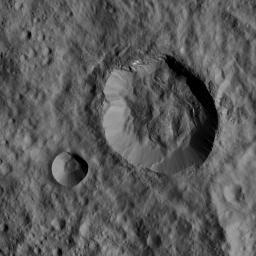
|
Dawn LAMO Image 20
- Click the image above for a larger view
- Full-Res JPEG (1024 x 1024) (128.3 kB)
- Full-Res TIFF (1024 x 1024) (1.1 MB)
Caption:
This image, taken by NASA's Dawn spacecraft, shows two relatively young, fresh craters on Ceres. The larger of the two is about 10 miles (16 kilometers) in diameter, while the smaller one has a width of about 3 miles (5 kilometers).
Many features in the surrounding area have been subdued or erased by a smooth blanket of ejecta blasted out of these two craters during their formation. Large blocks of ejected material fell near the rims of the craters and onto the floor of the larger crater.
The image is centered at approximately 23 degrees south latitude, 279 degrees east longitude. Dawn captured the scene on Jan. 1, 2016, from its low-altitude mapping orbit (LAMO), at an approximate altitude of 229 miles (368 kilometers) above Ceres. The image resolution is 112 feet (34 meters) per pixel.
Background Info:
Dawn's mission is managed by JPL for NASA's Science Mission Directorate in Washington. Dawn is a project of the directorate's Discovery Program, managed by NASA's Marshall Space Flight Center in Huntsville, Alabama. UCLA is responsible for overall Dawn mission science. Orbital ATK, Inc., in Dulles, Virginia, designed and built the spacecraft. The German Aerospace Center, the Max Planck Institute for Solar System Research, the Italian Space Agency and the Italian National Astrophysical Institute are international partners on the mission team. For a complete list of acknowledgments, see http://dawn.jpl.nasa.gov/mission .
For more information about the Dawn mission, visit http://dawn.jpl.nasa.gov .
Cataloging Keywords:
| Name | Value | Additional Values |
|---|---|---|
| Target | 1 Ceres | |
| System | Main Belt | |
| Target Type | Dwarf Planet | Asteroid |
| Mission | Dawn | |
| Instrument Host | Dawn | |
| Host Type | Orbiter | |
| Instrument | Framing Camera (FC) | |
| Detector | ||
| Extra Keywords | Crater, Grayscale | |
| Acquisition Date | ||
| Release Date | 2016-02-04 | |
| Date in Caption | 2016-01-01 | |
| Image Credit | NASA/JPL-Caltech/UCLA/MPS/DLR/IDA | |
| Source | photojournal.jpl.nasa.gov/catalog/PIA20310 | |
| Identifier | PIA20310 | |
